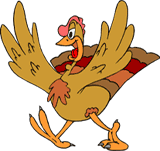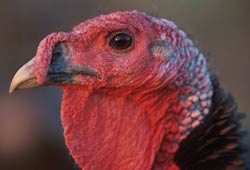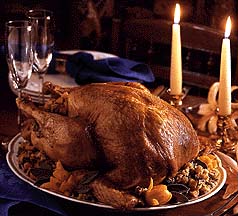| EVERYTHING YOU ALWAYS WANTED TO KNOW ABOUT TURKEYS BUT WERE AFRAID TO ASK 
How The Turkey Got Its Name

There are a number of possibilities on why turkeys are called turkeys. Some say Columbus thought the land he discovered was connected to India which had a large population of peacocks. Columbus thought turkeys were part of the peacock family. He decided to call them tuka, which is the word for peacock in the language of India.Others say that the name turkey came from Native Americans who called the birds firkee, which sounds like turkey. Some say that turkey name came from the sound turkeys make when they are afraid - "turk, turk, turk."
The Biggest Turkey
Several varieties of turkeys live in America. The largest is the Bronze turkey. The adult male or tom weighs up to 50 pounds while the female or hen can weigh up to 16 pounds. These larger turkeys are still popular for use in restaurants but are too large for even the most well attended family gathering.
Gobble, Gobble!

Only the adult male turkey makes the gobbler, gobble sound. The adult male is called the "tom" turkey. The female or hen turkey makes a gentle clucking or clicking sound. The hen never gobbles.
What's a Wattle Anyway?

The head and neck of turkeys have no feathers; rather it is covered with red, fleshy skin. A soft floppy growth on the front of the head, which dangles downward over the beak, is called the snood or dewbill. The turkey also has a pouchlike area at the front of his throat which is called a wattle. The head, neck, snood and waddle are all reddish colored until the male turkey begins to do his "strut" or mating dance at which time the entire area turns brilliantly bright red.
Struttin' His Stuff

In pictures and drawings, the male turkey is usually shown in his proudest moment. For those of you who have not seen a real turkey, the puffed up picture is actually the male turkey and this is not his usual stance. This feather works display only lasts for a few minutes but it can be seen several times daily. The male turkey in full plumage is dignified and almost royal in appearance. As his dance begins, the body stiffens and he gobbles loudly holding his head high, piercing black eyes looking straight ahead. His huge chest is thrust forward. Each feather stands apart with his tail feathers fanned. His wings actually drape down and drag the ground as he stamps his spurred feet. Moving in a circle around the barnyard for all to seen. For a few glorious minutes each day, he is the finest, most magnificent animal on the farm. The tom turkey does this number to attract the attention of the female, of course, who never seems to look directly at him. When he is not "strutting" about, the tom turkey looks much like the hen, only larger. As for strutting his stuff, no one and nothing does it better than the proud, adult tom turkey.
Turkey Eggs
Although wild turkeys like to rest in trees at night, they build crude nests of dry leaves on the ground. Turkey eggs are almost twice as large as ordinary chicken eggs. They have a pale creamy-tan color, with dark brown speckles. The huge yolk is golden-orange in color. Fertile turkey eggs take 30 days to hatch.
White Meat or Dark?

Did you ever wonder why the breast and wings of chickens and turkeys have white meat while the legs and thighs are dark? The explanation is a physiological one involving the function of muscles, which gives some insight into humans as well as animals. The dark coloration is not due to the amount of blood in muscles but rather to a specific muscle type and it's ability to store oxygen.
Too Big to Breed
The most prized portion of the turkey is the white meat of the breast. Because Americans like white meat so much, turkeys are bred to produce large breasts. Our domesticated turkeys have such large chests that the male, "tom turkey" is not able to fertilize the eggs of the female, "hen turkeys" in the natural mating position. Today, turkey eggs are fertilized by artificial insemination for the hatchery.
Americans Love Turkey
Over the past 20 years, Americans' consumption of turkey has increased dramatically. In 1975, Americans ate 8.3 pounds of turkey per year and in 1995, Americans ate over 18 pounds of turkey per year.
Learn about the different types of turkeys HERE. 
PAGE DESIGN, TURKEY BACKGROUND, & NEXT BUTTON BY FOREVER AMBER TURKEY ON SPIT FROM JO'S WORLD TURKEY #1 FROM ALL THAT GLITTERS TURKEY #2 FROM WKTI TURKEY #3 FROM LEWIS COUNTY ID TURKEY #4 FROM GOSHEN EDU TURKEY #5 FROM STATIC.WIRED TURKEY #6 FROM ALL ABOUT HOME TURKEY #7 FROM NISMAT TURKEY #8 FROM RCS_K-12_VA TURKEY #9 FROM YOUR TREASURES 
|  Free Forum Hosting
Free Forum Hosting